Explainer
- Explainer
- Islam
Two million people, 300 escalators, one holy mission. What is the Haj?
Every able-bodied Muslim is meant to do the Haj once in their lifetime. Why? What does it mean? And what do pilgrims actually do along the way?
By Maher Mughrabi and Felicity Lewis
Pilgrimages are undertaken by religions of all stripes but few are as epic as the Haj. An annual five-day affair, its tens of thousands of participants travel from around the world to a desert valley to perform ancient rituals that cannot be done in any other place at any other time of the year.
For many of them, it will be the peak experience of their life.
With crowds of more than 2 million pilgrims undertaking the 60-kilometre journey by foot, it is also a challenge for organisers to prevent crushes such as the 2015 stampede in which hundreds were killed.
Here's what it's all about.
What is the Haj and what is it for?
The Haj is a pilgrimage (which is also the meaning of the word in Arabic) that is supposed to be undertaken by every able-bodied Muslim who has the means once in their lifetime. It's held annually during Dhu al-Hijja, the last month of the Islamic calendar, falling this year between August 9 and 14.
“This is the highlight of one's life,” says Islamic Council of Victoria vice-president Adel Salman, who has travelled to Mecca to perform the Haj.
“It’s exhausting, it’s expensive [but] you’re there just to, effectively, worship your Lord in the holiest place, for Muslims, on Earth.”
Not only is the Haj about connecting to God, he says, but also to past prophets: the pilgrimage re-enacts the journey of the prophet Muhammad in 632 AD who was, in turn, re-enacting the journey of the patriarch Ibrahim (Abraham), his wife Hajar (Hagar) and son Ismail (Ishmael). With participants travelling from around the world, the Haj also connects Muslims to the global community of Islam.
I came back different. More conscious, more patient, more focused.
It is believed that undertaking the Haj will cleanse the believer of their sins and return them to a state of grace. “It has elements of being born again,” says Salman, “of renewing yourself spiritually.”
The pilgrims adopt a form of ritual purification and dress known as ihram, which for men involves wearing two pieces of white fabric with no seams or needlework and for women involves a white robe that covers the body, apart from the face and hands. Wearing scent or makeup is forbidden and there is no gender segregation during the pilgrimage. The aim is to eliminate distinctions in social status and gender, prefiguring the Day of Judgement.
The Haj is also a chance for Muslims to wipe the slate clean with others in their community. Before setting off, pilgrims seek the forgiveness of those who might be harbouring grievances against them and offer to pray for them in Mecca.
On their return, pilgrims will often be referred to by the honorific Haj or Haji and men sometimes dye their beards red to indicate that status.
“I came back different,” says Salman. “You eventually get back to life and it overtakes you [but] for a period of time after coming back, I was a lot more conscious, more patient, more focused. Not that I'm a superficial person but I found myself wanting to move beyond superficialities and connect.”
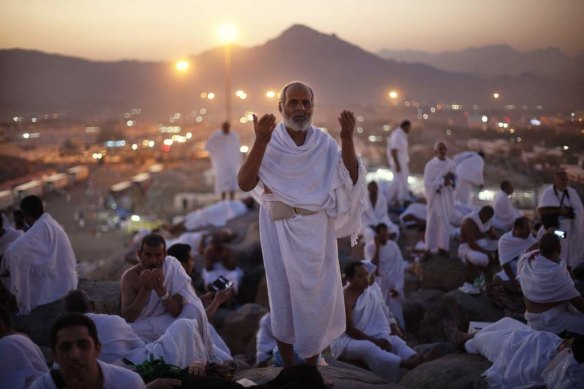
A pilgrim prays atop Mount Arafat during the Haj.Credit: Reuters
Why is the Haj in Saudi Arabia?
The city of Mecca, in modern-day Saudi Arabia, is where the prophet Muhammad was born and raised, and the place from which he was forced to flee when he began revealing God's word and to which he and his followers – the nascent Muslim community – returned in triumph before his death.
Mecca and Medina, 340 kilometres to the north, have been holy sites in Islam for 14 centuries; the Kingdom of Saudi Arabia is less than a century old.
For nearly 400 years prior to World War I, the territory of Hejaz was part of the Ottoman Empire, with custodianship of the holy cities in the hands of the Hashemites, an Arab dynasty that traced its lineage to the prophet Muhammad. As the empire crumbled, the Hashemites allied themselves with the British and declared an independent kingdom with Mecca as its capital. However, in 1925 Hejaz was conquered by another dynasty from eastern Arabia – the Sauds. The Saudi kings have since styled themselves the Khadim al-Haramain – custodian (or servant) of the two sacred places.
This year a small group of Muslims have taken to Twitter to publicise their boycott of the Haj because it takes place in Saudi Arabia, citing the Saudis' role in the war in Yemen, its stance on human rights and its unequal treatment of women.
How many people do the Haj?
With easier air travel and a growing Muslim population, the number of people making the Haj has hovered between 2 million and 2.5 million, hitting a peak of more than 3 million in 2012 and a low of 1.86 million in 2016, the year after a catastrophic crush on the route killed more than 2000 people.
Given that a quarter of the world's population is Muslim, there's not room for everyone in this small patch of desert.
All Muslims, provided they can obtain a visa from the Saudi authorities, are eligible to attend. Children will usually not be given a visa unless accompanied by their parents and women are unlikely to be given a visa unless accompanied by a male spouse or guardian. Those who perform the Haj as children are generally expected to perform it again as adults, when they have the power of individual consent.
But, given that a quarter of the world's population is Muslim, there's not room for everyone in this small patch of desert. The New York Times recently calculated that if all the world's Muslims wished to undertake the Haj, it would take them 581 years at present rates.
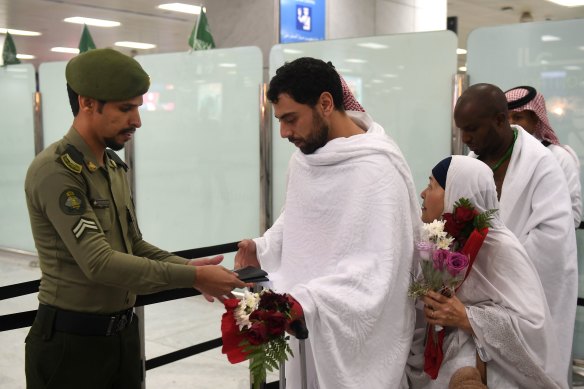
Families of victims of the Christchurch massacre arrive at Jeddah airport near Mecca on August 2.Credit: AFP
So the Saudi government allocates each of the world's nations a quota for the year's pilgrimage, with pilgrims booking their travel and accommodation – from first-class through to more basic – through accredited agents. Pilgrims arriving in Mecca must surrender their passports to Saudi authorities in return for a Haj ID, which they return in order to redeem their passport.
Nations typically are allowed 1 pilgrim per 1000 Muslims in their population, though Saudi Arabian citizens can apply once every five years. In Indonesia – the nation with the world's largest Muslim population, which was allocated 204,000 places this year – millions of people are on provincial waiting lists ranging from 12 to 17 years.
Saudi authorities have this year authorised Haj visas for 4500 Australians.
Australia is home to about 600,000 Muslims but Saudi authorities have this year authorised Haj visas for 4500 Australians, according to the Saudi embassy in Canberra. King Salman has also arranged for the hosting of 200 pilgrims from the families of victims of the Christchurch mosque attacks.
After a meeting between Saudi Crown Prince Mohammed bin Salman and Indian Prime Minister Narendra Modi this year, India's quota was raised from 170,000 to 200,000 pilgrims.
On the eve of the 2015 pilgrimage, then Haj minister Bandar al-Hajjar – who lost his job after that year's disastrous crowd crush – was quoted as predicting pilgrim numbers in 2016 would grow to 5 million, on their way to 30 million within five years. These days officials say they aim to accommodate 5 million pilgrims in 2020, and this year's Haj will be a key test of that ambition.
These days Muslims can use technology to help them navigate Haj rituals, from the Manasikana app that also alerts them to when they are straying from the areas of worship to the Asefny app for medical emergencies. After the 2015 disaster, electronic ID bracelets connected to GPS were introduced.
What is the route for the Haj?
Six stages in the Haj
- In the Grand Mosque, pilgrims walk en masse around the Kaaba – which Muslims believe to be the first mosque – to emphasise the unity of the believers, a ritual called tawaf. The pilgrims then walk between the "hills" of Marwa and Safa, huge mounds of rock that the mosque building has been extended to cover. They do this seven times, to symbolise the search for water of Ismail and his mother, Hajar. As a memento, many pilgrims take water from the well of Zamzam, which sprang up to quench the pair's thirst.
- After a night in a vast "encampment" of tent-like buildings at Mina, the pilgrims walk to the top of the hill known as Mount Arafat for prayer and contemplation from noon to dusk. The prophet Muhammad delivered his final sermons here.
- The pilgrims walk down the hill to Muzdalifa to spend the night in prayer, and collect pebbles which they will later throw at a representation of the Devil, who tormented Ibrahim in the desert.
- From Muzdalifa, they cross the Jamarat bridge and "stone" three walls that represent the Devil before doing a U-turn back towards Mina. In the past, this has been a major chokepoint for crowds but the bridge now has four storeys and more than 300 escalators.
- The pilgrims return to the Grand Mosque and walk around the Kaaba again.
- They change out of their ritual white robes into festive clothes and sacrifice sheep, re-enacting the sacrifice Ibrahim made instead of his son, to mark the beginning of the celebrations of Eid. They can stay in Mina for two or three nights.
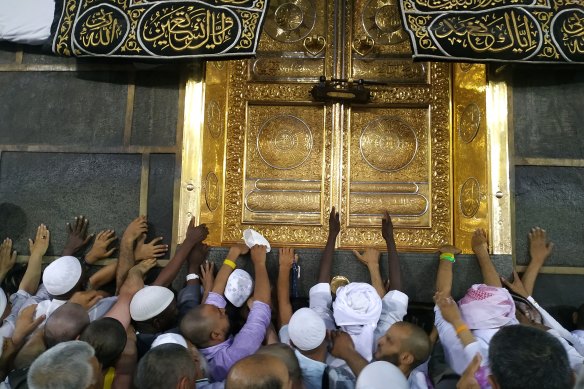
Pilgrims touch the Kaaba, which they believe to be the first mosque.Credit: Getty
What is the big black box the pilgrims walk around?
The Kaaba (or Cube) is a granite building about 13 metres high and it is this that Muslims worldwide turn to in prayer five times a day – they believe the Kaaba was built as a place of worship by Ibrahim and Ismail on God's instructions.
For Adel Salman, who was 35 when he undertook the Haj, the most powerful moment was seeing the Kaaba for the first time. “I actually started crying. I was like a little kid. I was just overwhelmed that I was here in the holiest place on Earth and I was here in the house of God.”
I actually started crying. I was like a little kid. I was just overwhelmed that I was here in the holiest place on Earth.
Inside, the Kaaba is marble-clad with three pillars, a small altar and a black stone set in the eastern corner, which has been variously identified as a slab of ancient agate or a piece of meteorite. The exterior is draped in a black silk curtain called the Kiswa, embroidered with 15 kilograms of gold thread and costing more than $6.5 million. It is replaced each year during the Haj, with the old Kiswa being cut up and offered to Muslims as sacred gifts. In 1983, the United Nations in New York was given part of a Kiswa to exhibit.
What if you are old, infirm or don't like crowds?
The Haj is not meant to be undertaken by those who are physically infirm – it is an arduous route – but that does not stop many Muslims approaching the end of their lives attempting it. As Salman points out, even though younger Muslims are encouraged to undertake the Haj, it takes some aspiring pilgrims a lifetime to save the money for the trip – and going late in life means you can be absolved of a lifetime's sins.
The heat, the stress, the crowds are a recipe for friction and conflict but pilgrims tend to keep it together.
The Saudi embassy in Canberra says this year authorities have 25 hospitals with 5250 beds and 141 health centres on standby. “All health services are provided free of charge, even complicated and costly interventions such as open-heart surgeries,” the embassy told The Age and Sydney Morning Herald. “Traditionally, cardiovascular diseases, heat exhaustion and dehydration, burns, food poisoning as well as kidney problems are leading causes of medical interventions during the pilgrimage season.”
While Adel Salman agrees that Haj conditions – the crowds, the heat, the stress – are a recipe for friction and conflict, he says pilgrims tend to keep it together.
“Everyone was quite stressed and tired. A couple of times I had to hold myself because I was hoping people would move quicker [but] I bit my tongue,” he says. After all, everyone is savouring a rare opportunity. “You don't want to throw it away,” he says.
If the pilgrimage was planned far enough in advance, it could be undertaken in a year when Dhu al-Hijja falls in the northern autumn or winter, when temperatures in Saudi Arabia are cooler and days shorter.
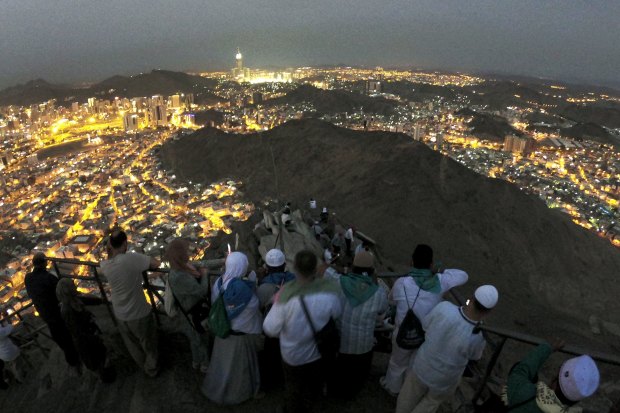
Muslim pilgrims view Mecca from the Jabal al-Nour (mountain of the light) during this year's Haj. A cave in the mountain is believed to be the site of Muhammad's first revelation from God.Credit: Anadolu
Is the Haj safe? How do the Saudis manage crowds?
The main logistical challenge of hosting the Haj is that all pilgrims must perform the ritual within the timeframe of just a few days; it is not possible to stagger the huge numbers of people involved. This means enormous simultaneous demand on toilets and – given the advanced age of many pilgrims – medical services. The Grand Mosque itself is built to accommodate 1.2 million people in prayer at once.
Saudi Arabia has a standalone ministry for Haj affairs and during the pilgrimage there is a special three-digit number for emergency calls that puts people through to one of several control centres. On the Jamarat bridge, one of the major enclosed parts of the route, there are 308 escalators in place to help streamline pilgrims and specially constructed elevators that can hold an ambulance take emergency patients to helipads at roof level. To deal with language barriers, medical teams are supplied with special picture books that help patients communicate the character of their illness or injury.
The halls where pilgrims stone a wall representing the Devil on the bridge were once circular, but studies revealed this to be a major cause of crowd flow problems and crushing, and so the halls are now ellipse-shaped.
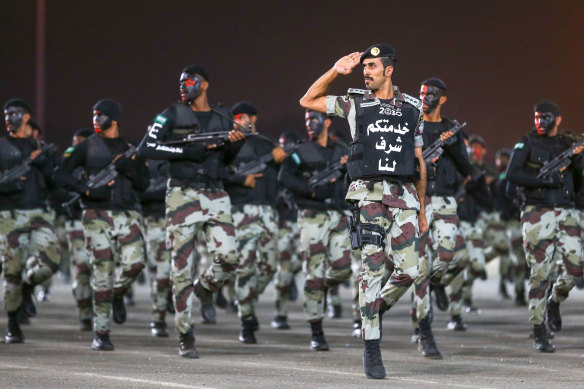
Saudi security forces parade on the eve of the Haj. The writing on the officer's chest reads "serving you is an honour for us".Credit: AFP
Is it possible to do a Haj-lite?
There is no alternative to performing the Haj for meeting a Muslim's religious obligation, however many Muslims who, for whatever reason, are unable to schedule a pilgrimage within the prescribed dates will journey to Mecca at another time of the year for a less arduous pilgrimage known as Umrah.
Can you send a proxy to perform Haj?
It is often asked whether it is permissible to fund someone else to perform the Haj on your behalf or on behalf of a relative who has died without making the pilgrimage. Although there are differing positions depending on Islamic schools of thought, it is generally considered that while paying for another to perform Haj is a worthy act, it cannot be a substitute for meeting one's own spiritual obligation. If you are mature, sane and physically capable, then failure to perform the Haj is a neglect of religious duty.
Are any Muslims definitely not going?
More than 100 Muslims from Australia to Tanzania are contributing to a Twitter hashtag #boycotthajj in response to Saudi Arabia's human rights record.
“#BoycottHajj is an important discussion for Muslims to have. It is about being critical and recognising the atrocities that the Saudi regime commits against fellow Muslims,” Mariam Parwaiz, a public health doctor in New Zealand, said on Twitter.
A Saudi official dismissed the boycott as “unwise”. “Those people are trying to politicise haj,” he told Reuters. “Haj is separate. Haj has nothing to do with all this – this is a spiritual trip.”
Let us explain
If you'd like some expert background on an issue or a news event, drop us a line at explainers@smh.com.au or explainers@theage.com.au. Read more explainers here.